Research Suggests Better Survival Rates for Dogs With Bloat

Gastric dilation and volvulus (GDV), or bloat, is terrifying. It comes on fast, and out of nowhere, and it can be deadly if not attended to immediately. Dr. Dan O’Neill is a veterinary epidemiologist at the Royal Veterinary College in the UK and he says it is imperative that veterinarians work to let patients know the symptoms so it can be recognized and treated as soon as possible. O’Neill says bloat is literally a race of time in a dog’s life, and is a top killer of dogs.
Related: What is Dog Bloat?
He recently released information from a study by VetCompass at the Royal Veterinary College that showed 80% of dogs who had surgery for gastric bloat survived, though, and found new information about risk factors, survival rates from bloat and the frequency in which it occurs.
The study looked at over 77,000 dogs from 50 veterinary clinics in the United Kingdom from 2012 to 2014. While it didn’t necessarily give any new information about the elusive cause(s) of bloat in dogs, it did confirm that there are certain dogs who have a genetic predisposition to bloat.
When a dog is affected, its stomach fills with gas. This causes its stomach to completely twist around and trap the gas. Because the gas has no way to escape, the stomach can no longer get air or blood, which makes it swell more. It then pushes against the abdominal wall and causes the compression of large blood vessels, and untreated, ends in death, typically due to the body’s shock. Dr. O’Neill says that whole process can take several hours or several minutes and is terrifying for owners.
Those who have deep-chested dogs like Great Danes, French Mastiffs and standard poodles should pay particular attention to the symptoms of bloat, as those breeds are at higher risk. The study also found that older dogs have an increased risk of getting bloat, and neutered males are three times more likely to develop bloat than female dogs are.
Prior to this study, the diagnosis of bloat was believed to very likely be a death sentence because surgery as the solution had mixed results. Twenty years ago, the mortality rates for dogs who underwent surgery to correct bloat was 50%, but today, the study found that less than a quarter of dogs who go through bloat surgery end up dying anyway. Dr. O’Neill believes that this is because there is better treatment for shock, better surgical methodology and better anesthesia for dogs that is used in surgery.
Related: I Can’t Afford My Dog’s Vet Bill! What Do I Do?
Knowing this information, Dr. O’Neill says that vets can show owners factual science to help them make better decisions when it comes to breed selection or even whether or not to do the surgery. Before, many opted not to, fearing the risk of death was still too high. Now, he says that four of five dogs who are operated on at animal emergency centers can survive, which means that vets may be able to share better prognoses for dogs who are diagnosed with GDV.
He says that this means humans may have much better chances of keeping their furry friends with them after surgery, despite current and previous beliefs it’s practically a death sentence, and help humans be more aware of the possibilities.

More by Lori Ennis























